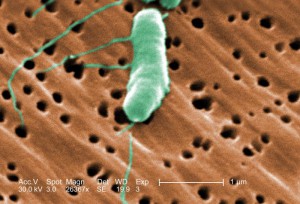After the recent report of a fatality due to the Vibrio bacteria near Tampa many locals have become concerned about their safety when entering the Gulf of Mexico this time of year. So what are the risks and how do you protect yourself?
What is the Flesh Eating Disease Vibrio?
Vibrio vulnificus is a salt-loving rod-shaped bacteria that is common in brackish waters. As with many bacteria, their numbers increase with increasing temperatures. Though the organism can be found year round they tend peak in July and August and remain elevated until temperature decline.
How do people contract Vibrio?
The most common methods of contact with Vibrio are entrance through open wounds exposed to seawater or marine animals and by consuming raw or undercooked shellfish, primarily oysters. The bacterium can also be contracted by eating food that is either served, and has made contact with, raw or undercooked shellfish or the juice of raw or undercooked shellfish.
What is the risk of serious health problems after contracting Vibrio?
Cases of Vibrio infection are rare and the risk of serious health problems is much higher for humans who are have a suppressed or compromised immune system, liver disease or blood disorders such as iron overload (hemochromatosis). Examples include HIV positive, in the process of cancer treatment, and studies show a particularly high risk for those with a chronic liver disease. The Center for Disease Control indicates that humans who are immunocompromised have an 80 times higher chance of serious health issues from Vibrio than healthy people. He also found that most cases involve males over the age of 40. According to the Center for Disease Control there were about 900 cases reported between 1988 and 2006; averaging around 50 cases each year. The Florida Department of Health reported 32 cases of Vibrio infections within Florida in 2014 with 7 of these begin fatal. Five of the cases were in the Florida panhandle but none were fatal. So far this year in Florida there have been 11 cases statewide, 5 of those fatal. Only 1 case was in the panhandle and it was nonfatal. Though 43 cases and 12 fatalities over the last two years in Florida are reasons for concern, when compared to the number of humans who enter marine and brackish water systems every day across the state, the numbers are quite low.
What are the symptoms of Vibrio infection?
For healthy people who consume Vibrio containing shellfish symptoms could include vomiting, diarrhea, and abdominal pain. Wounds exposed to seawater that become infected will show redness and swelling. For the at-risk populations described above the bacteria will enter the bloodstream and rapidly cause fever and chills, decreased blood pressure, and blistering skin lesions. For these at-risk population 50% of the cases are fatal and death generally occurs within 48 hours.
It is important that anyone who believes they are at high risk and have the above symptoms that they seek medical attention as quickly as possible.
How can I protect myself from Vibrio infection?
We recommend anyone who has a chronic liver condition, hemochromatosis, or any other immune suppressing medical condition, not consume raw or undercooked filter-feeding shellfish and not enter the water if they have an open wound.
The Center of Disease Control recommends
- If harvesting or purchasing uncooked shellfish do not consume any whose shells are already open
- Keep all shellfish on ice and drain melted ice
- If steaming, do so until the shell opens and then for 9 more minutes
- If frying, do so for 10 minutes at 375°F
- Avoid foods served, and has had contact with, raw or poorly cooked shellfish or that has had contact with raw shellfish juice
- If shucking oysters at a fish house or restaurant, wear protective gloves
It is also important to know that the bacteria does NOT change the appearance or odor of the shellfish product, so you cannot tell by looking at them whether they are good or bad.
For more information on this bacteria visit:
http://www.floridahealth.gov/diseases-and-conditions/vibrio-infections/vibrio-vulnificus/
http://www.cdc.gov/vibrio/vibriov.html
- Pensacola Bay Invasive Species Summer Survey 2025 - November 3, 2025
- Our Environment: Part 24 – Our Changing Climate - November 3, 2025
- Our Environment: Part 23 – Hydrogen as an Energy Source - October 29, 2025

